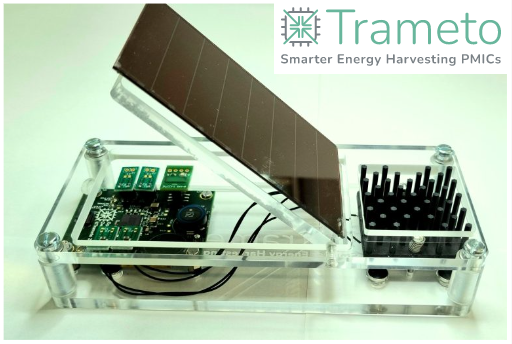In the challenging environment of IoT devices, where regular battery replacement is prohibitively expensive and environmentally damaging, Trameto’s OptiJoule™ energy harvesting power management ICs (EH PMICs) overcome the problem by efficiently and effectively processing even the tiniest amounts of energy derived from harvesting devices in the surrounding environment.
Since many IoT endpoints are sensors used mainly for data acquisition, much of the energy gathered by the device is wasted; it may only be sending data a few times per hour while harvesting energy almost all the time. Trameto’s solution makes sure this energy is put to good use by powering the device, or at least extending its battery lifetime.
The OptiJoule EH PMIC accepts input from light (outdoor or indoor), thermal gradient, or vibration energy harvesters. You can connect a single harvester to the EH PMIC, or up to four of the same, or a mix of types, and each input autonomously adjusts its characteristics to provide a perfect match for each harvester, capturing microwatts to milliwatts of energy. The EH PMIC then intelligently optimises the harvested energy to extract the most from all of the sources, all of the time. Simultaneously, it handles intelligent charge management of the energy store – whether that is a capacitor or re-chargeable battery – and delivers the power to the load efficiently when it is needed.
OptiJoule EH PMICs mean improved energy utilisation in a smaller footprint, a lower bill-of-materials through functional integration, reduced component inventory, and faster time-to-market by simplifying energy management design. This makes energy harvesting viable in a multitude of new applications, including smart buildings, consumer electronics, asset monitoring, agriculture, wearables, healthcare, and home automation.
To test this technology, Trameto created Severn, a compact platform to test their EH PMIC, the TM2040. While up to four harvesters can be connected without additional interface components, the Severn platform includes a photovoltaic (PV) harvester on a hinged backing to allow optimal positioning and a thermoelectric generator (TEG) with an air heatsink, all housed in an acrylic case; magnets facilitate the platform’s attachment to a warm, ferrous surface when working with the TEG.
The PMIC combines the energy from each input into the common store on the Severn platform, a super-capacitor. When the capacitor is fully charged, the TM2040 delivers a 1.8 V DC, regulated supply at up to 15 mA for powering wireless IoT sensors and modules. A Windows GUI is also available for displaying harvested power and status information, and daughter boards are available for additional energy inputs.
Now that’s a pretty cool chip!
Keep designing!
(Image sourced from Trameto)

